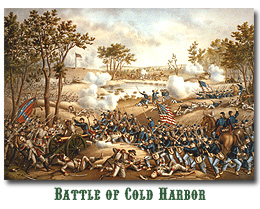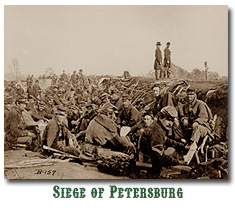Regimental
History: 1864
(continued)
 y the end
of May, command of the regiment
passed to Capt. James Fleming, who had begun his service as a sergeant
in Co. B and advanced steadily through the ranks in spite of being
wounded several times. One contemporary wrote of Fleming: "Small in
stature, very quiet and unassuming in his deportment, distrustful of
his own powers, it was only when under fire that he was seen to
advantage. Cool and brave, he was quick to seize any advantage the
enemy might leave open."
y the end
of May, command of the regiment
passed to Capt. James Fleming, who had begun his service as a sergeant
in Co. B and advanced steadily through the ranks in spite of being
wounded several times. One contemporary wrote of Fleming: "Small in
stature, very quiet and unassuming in his deportment, distrustful of
his own powers, it was only when under fire that he was seen to
advantage. Cool and brave, he was quick to seize any advantage the
enemy might leave open."
The 28th Massachusetts and the rest of the
Irish Brigade were pulled away from the Totopotomoy on the night of
June 1 and began marching toward Cold Harbor to the south.
Unfortunately, confusion over which roads they were supposed to take
delayed them from meeting up with the rest of the army until
mid-morning the next day. Lt. Martin Binney, acting adjutant of the
28th, remarked that the regiment "had a long, weary, rapid march; the
dust lay very heavy. This was the most severe march of the
campaign… ten and a half hours."
 Arriving on the left flank of Grant's
army, the exhausted men were permitted to rest for the remainder of the
day. But at daybreak on June 3, the 28th Massachusetts was again moved
forward and readied for another assault, assigned with the rest of the
Irish Brigade to the second line of Gen. Barlow's 1st Division. The
initial attack successfully captured enemy positions along a sunken
road, with many Confederate prisoners being sent to the rear. But the
second wave was sent in too slowly. By the time the men of the 28th and
their Irish Brigade caught up, they were met with a relentless
enfilading fire from Southern reinforcements.
Arriving on the left flank of Grant's
army, the exhausted men were permitted to rest for the remainder of the
day. But at daybreak on June 3, the 28th Massachusetts was again moved
forward and readied for another assault, assigned with the rest of the
Irish Brigade to the second line of Gen. Barlow's 1st Division. The
initial attack successfully captured enemy positions along a sunken
road, with many Confederate prisoners being sent to the rear. But the
second wave was sent in too slowly. By the time the men of the 28th and
their Irish Brigade caught up, they were met with a relentless
enfilading fire from Southern reinforcements.
Still determined to move ahead, Byrnes
pushed his Irish troops forward over the earthworks. They advanced
beyond two ridges to reach a hill well in advance of other Union
forces. Under the command of Lt. James B. West, the 28th Massachusetts
helped the Irish Brigade gallantly cling to this isolated and exposed
position for more than six hours. At nightfall, however, the Irishmen
finally moved back to a safer position and dug a new line of trenches.
The 28th Massachusetts suffered another 48 casualties at Cold Harbor,
including Lt. West, who was killed in action.
But for the regiment and the Irish Brigade,
there was an even more significant loss. As the Irish were falling back
from the hill, a Confederate bullet hit Col. Byrnes in the back and he
fell mortally wounded. Transported to a hospital in Washington, Byrnes
died there on June 12. Deeply moved by the loss of one of his most able
commanders, Maj. Gen. Hancock later noted in a report that Byrnes was
among a group of "most promising young officers who had never failed to
distinguish themselves in battle."
Thwarted at Cold Harbor, Grant's
next move was to
swing around Lee's entire army, cross the James River below Richmond,
and capture the crucial rail junction at Petersburg. For the next two
weeks, however, the 28th Massachusetts would remain in its
entrenchments at Cold Harbor, losing three more men to extreme heat and
not enough drinking water. On June 14, the regiment was ordered along
with the rest of the 2nd Corps to quickly march south and cross the
James River. By this time, casualties and hard marches had reduced the
regiment to just 100 enlisted men and two lieutenants, including
commander John B. Noyes, fit for duty.
 Late in the afternoon of June 16, the
regiment once again joined in an assault against entrenched rebel
positions in front of Petersburg. Helping take the first line of
Confederate works, the attackers became bogged down on a steep hill,
were turned back by a furious rebel counterattack, and then rallied to
repulse enemy forces. But the rebels had once more outpaced Grant's
advancing Union army, so both sides settled in for a long siege.
Late in the afternoon of June 16, the
regiment once again joined in an assault against entrenched rebel
positions in front of Petersburg. Helping take the first line of
Confederate works, the attackers became bogged down on a steep hill,
were turned back by a furious rebel counterattack, and then rallied to
repulse enemy forces. But the rebels had once more outpaced Grant's
advancing Union army, so both sides settled in for a long siege.
In the action of June 16, the 28th
Massachusetts suffered another 19 casualties. Col. Patrick Kelly, who
had taken over command of the Irish Brigade for the second time after
Byrnes' death two weeks earlier, was among those killed. Capt. Richard
Moroney of the 69th New York would succeed him, being the most senior
officer remaining in the ranks, but by this time, the original Irish
Brigade was so depleted that it had, for all intents and purposes,
ceased to exist.
The 28th Massachusetts alone had lost more
than 400 men, including eight officers killed and 12 wounded. On June
20, the 28th was transferred to the 1st Brigade, which included a
number of other depleted 2nd Corps regiments: the 26th Michigan, 5th
New Hampshire, 2nd and 4th New York Heavy Artillery, 61st New York
Infantry, and 81st, 140th and 183rd Pennsylvania regiments. The new
combined brigade was placed under the command of Col. James Lynch in
Brig. Gen. Nelson Miles' 1st Division.
For the next four months, the 28th
Massachusetts would be the only unit from the Irish Brigade to remain
in the field, building on its reputation for dash and gallantry. During
a June 22 battle along the Jerusalem Plank Road, the men of the 28th
were deployed as skirmishers and helped turn back a vigorous enemy
attack, losing 12 more men and earning compliments from Gens. Barlow
and Miles in their official reports on the action.
From this time until July 9, the 28th was
kept in reserve, then assigned relatively quiet picket and fatigue
duties until July 26. The regiment was then ordered to make a long
night march, crossing both the James and Appomattox rivers as part of a
general movement against the Confederate left flank near Richmond.
 At Deep Bottom, the men of the 28th were
once again deployed as skirmishers, joining in an attack on the right
side of the rebel line on July 27. Under the brave leadership of Capt.
Fleming, the regiment successfully turned the enemy's left flank,
sending the rebels fleeing from their trenches in great confusion. The
28th Massachusetts entered the Confederate works ahead of its brigade,
capturing four 24-pounder Parrott guns, caissons, ammunition and
several prisoners, including the commander of the rebel battery - all
at a loss of only four men. Col. James Lynch, leading the brigade,
praised Capt. Fleming in his official report, stating "to his gallantry
was due, in great measure, the success of the assault."
At Deep Bottom, the men of the 28th were
once again deployed as skirmishers, joining in an attack on the right
side of the rebel line on July 27. Under the brave leadership of Capt.
Fleming, the regiment successfully turned the enemy's left flank,
sending the rebels fleeing from their trenches in great confusion. The
28th Massachusetts entered the Confederate works ahead of its brigade,
capturing four 24-pounder Parrott guns, caissons, ammunition and
several prisoners, including the commander of the rebel battery - all
at a loss of only four men. Col. James Lynch, leading the brigade,
praised Capt. Fleming in his official report, stating "to his gallantry
was due, in great measure, the success of the assault."
While it may have seemed a significant
victory to men in the ranks, the attack was launched only to divert
rebel attention from the major federal effort against Petersburg lines.
On the evening of July 28, the 2nd Corps moved back along the New
Market road and built breastworks, subsequently returning to the
Petersburg lines and remaining in the trenches there, ready to support
the failed 9th Corps assault known as the Battle of the Crater on July
30.
The 28th Massachusetts
left its old
Petersburg encampment on August 12 and marched back to the James River.
This time, however, the regiment boarded transport boats that were
gathered at the docks. As the transports began to move downriver,
rumors spread among the depleted ranks of the 2nd Corps that they were
being sent to Washington for much-needed rest and recruiting. But the
movement turned out to be a ruse, and as night descended, the
transports turned around and docked in the vicinity of Deep Bottom.
At daybreak on what turned out to be an
oppressively hot morning, the 2nd Corps advanced in support of a
planned 10th Corps attack against Confederate positions. The 28th
Massachusetts was sent in to make a demonstration against a rebel
battery, suffering 15 casualties, including the death of Capt. Patrick
Nolan.
On August 16, the men of the 28th deployed as skirmishers in support of
Gen. Gregg's cavalry on the right of the Union line. After stubbornly
resisting superior rebel numbers near the Charles City Cross Roads, the
regiment fell back to its brigade, losing 18 killed and wounded and 22
captured.
Stymied in its attempts to advance on
Richmond, Gen. Hancock's 2nd Corps was ordered back to the Petersburg
lines on August 17, having accomplished little for its efforts. Less
than two weeks later, the 28th was ordered on a 35-mile forced march
behind and around the Union lines to join the rest of the 2nd Corps in
destroying the Confederate railroad leading to Weldon. For the next
four days, they assisted in these efforts to break up the tracks.
On August 25 came a fierce rebel attack at
Reams' Station. After helping repulse three successive Confederate
assaults, the 28th Massachusetts was finally driven from its
breastworks. The regiment was reportedly among the last to abandon the
Union trenches and first to reoccupy them after the federals launched a
successful counterattack. In this engagement, the 28th lost another 34
men; ten killed or wounded and 24 captured or missing.
 After this engagement, the 28th
Massachusetts fell back with its division to the Williams farm near the
main federal lines, remaining there until August 27. The regiment moved
to Fort Davis and was encamped in and around that post through
December, periodically manning trenches and fortifying earthworks in
front of Petersburg. While not engaged in any major battles, the 28th
endured regular bombardments and suffered three casualties on the
picket line.
After this engagement, the 28th
Massachusetts fell back with its division to the Williams farm near the
main federal lines, remaining there until August 27. The regiment moved
to Fort Davis and was encamped in and around that post through
December, periodically manning trenches and fortifying earthworks in
front of Petersburg. While not engaged in any major battles, the 28th
endured regular bombardments and suffered three casualties on the
picket line.
The terms of service for
those men who had
not re-enlisted the previous winter expired on December 19. One
officer, Lt. Col. Cartwright, and 20 enlisted men remained among this
group and were able to return home. Their departures punctuated a very
long year for the 28th Massachusetts, during which the regiment lost
408 men - including eight commanding officers - to death, wounds,
disease, and disability. Among all its commissioned officers, only one
escaped unhurt during the fearful Overland Campaign.
Continued
>

